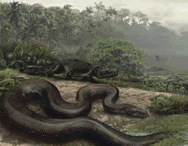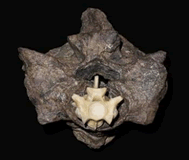|
Largest Snake-world record set by Titanoboa
COLOMBIA, South America -- Excavations in Colombia
co-organized by Carlos Jaramillo, staff scientist at the Smithsonian
Tropical Research Institute in Panama and Jonathan
Bloch, curator of vertebrate paleontology at the University
of Florida's Florida Museum of Natural History, unearthed
fossil remains of a new snake species named Titanoboa cerrejonensis
which must have reached 13 meters (42 feet) in length and
weighed more than a ton-setting the world record for the Largest
Snake.
Photo: Artist's impression of the giant
snake Titanoboa cerrejonensis which measured 43 feet
(enlarge
photo)
"Truly enormous snakes really spark people's
imagination, but reality has exceeded the fantasies of Hollywood,"
said Jonathan Block, a vertebrate palaeontologist at the University
of Florida, who co-led the work.
"The snake that tried to eat Jennifer Lopez in
the movie 'Anaconda' is not as big as the one we found." "At
its greatest width, the snake would have come up to about
your hips," said David Polly, a geologist at the University
of Indiana at Bloomington.
Surrounded by huge trucks extracting coal
from Cerrejon, one of the world's largest open-pit mines,
researchers discovered fossilized bones of super-sized snakes
and their prey, crocodiles and turtles, in the Cerrejon Formation,
along with fossilized plant material from the oldest known
rainforest in the Americas, which flourished at the site 58-60
million years ago.
Titanoboa,
as it is now called, is the largest snake ever known, and
was the largest non-marine vertebrate from the epoch immediately
following the extinction of dinosaurs 65 million years ago.
"The discovery of Titanoboa
challenges our understanding of past climates and environments,
as well as the biological limitations on the evolution of
giant snakes." said Head
"This shows how much more information about
the history of Earth there is to glean from a resource like
the reptile fossil record."
Jason Head, the lead author of the new
species description in the journal Nature, is a research associate
at the Smithsonian's National Museum of Natural History and
assistant professor of ecology and evolutionary biology at
the University of Toronto Mississauga.
Head, with David Polly, associate professor of
geosciences at Indiana University, used the ratio between
vertebral size and the length of existing snakes to estimate
that this boa-like snake must have reached 13 meters (42 feet)
in length and weighed more than a ton. 
The size of the snake's vertebrae suggest the
beast weighed some 1.135 tonnes, in a range of 730 kilos (1,600
pounds) to 2.03 tonnes.
Photo: The vetebrae of the world's biggest
snake is compared with the vertebrae (in white) of a modern
17 foot Anaconda (enlarge
photo)
And it measured 13 metres (42.7 feet) from nose
to tail, in a range of 10.64-15 metres (34.6-48.75 feet),
they estimate.
Titanoboa's
size indicates that it lived in an environment where the average
yearly temperature was 30-34 degrees Celsius. This estimate
coincides with paleoclimatic models predicting greenhouse
conditions. "This temperature estimate is much hotter than
modern temperatures in tropical rainforests anywhere in the
world.
The fossil floras that the Smithsonian has been
collecting in Cerrejon for many years indicate that the area
was a tropical rainforest. That means that tropical rainforests
could exist at temperatures 3-4 degrees Celsius hotter than
modern tropical rainforests experience," said Jaramillo.
Support for this research comes from the National
Science Foundation, Fondo para Investigaciones del Banco de
la Republica de Colombia, Smithsonian Tropical Research Institute
Paleobiology Fund, the Florida Museum of Natural History,
a Geological Society of America Graduate Student Research
Grant and a National Sciences and Engineering Research Council
of Canada Discovery Grant and the Cerrejon Coal Mine.
STRI,
headquartered in Panama City, Panama, is a unit of the Smithsonian
Institution. The institute furthers the understanding of tropical
nature and its importance to human welfare, trains students
to conduct research in the tropics and promotes conservation
by increasing public awareness of the beauty and importance
of tropical ecosystems. Web site:
www.stri.org.
The longest snake ever measured was 10 meters
(33 feet) in length. The heaviest snake, a python, weighed
183 kilograms (403 pounds).
Authors and institutions:
- Jason J. Head, University of Toronto
-Jonathan I. Bloch, University of Florida, Gainesville
-Alexander K. Hastings, University of Florida,
Gainesville
- Jason R. Bourke, University of Florida, Gainesville
-Edwin A. Cadena, Smithsonian Tropical Research Institute;
University of Florida, Gainesville
-Fabiany A. Herrera, Smithsonian Tropical
Research Institute; University of
Florida, Gainesville
-David Polly, Indiana University, Bloomington
-Carlos A. Jaramillo, Smithsonian Tropical Research
Institute
Related world records:
Smallest
snake-Leptotyphlops carlae sets
world record
Largest
number of bird species spotted-world record set by Alan Davies
and Ruth Miller
Biggest
rabbit-world record set by Herman the giant rabbit
Oldest
cat-world record set by Mischief
Largest
potato-world record set by Khalil Semhat
Largest
rutabaga-world record set by Norm Craven
Oldest
living animal- world record set by Jonathan the tortoise
Largest
school of sharks-world record set by the Dubai Aquarium
Most
cobs on a maize plant-world record set by Mark Wozencroft
Longest
cucumber-world record set by Alf Cobb
Largest
marrow -world record set by Ken Dade
Longest
Spaghetti Bean-world record set by Toni Velardo
Longest
water spinach-world record set by Li Hui
Biggest
Chicken Egg-world record set by "Titi"
Largest
horizontal wall of flowers-world record set by Thompson and
Morgan
Largest
Oyster- Richard Mesce sets world record
Oldest
living tree-world record set by a Swedish spruce
Wednesday,
February 4, 2009
|
















